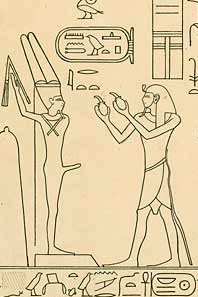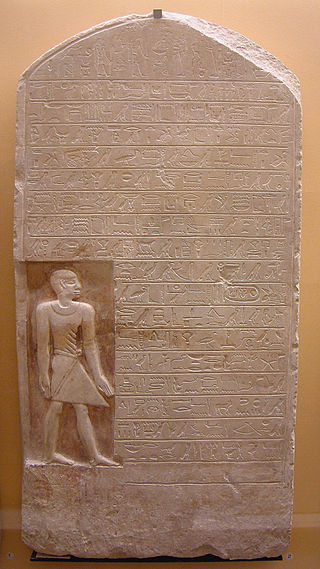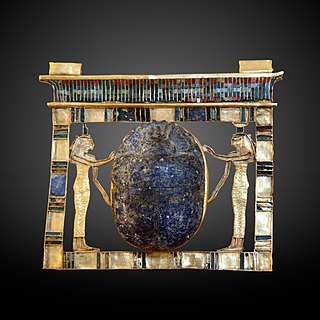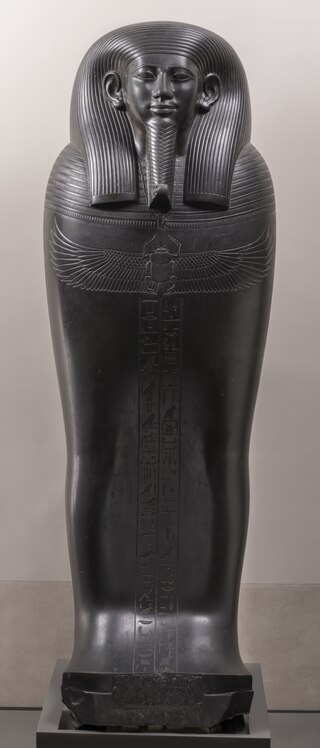
Amenemhat III, also known as Amenemhet III, was a pharaoh of ancient Egypt and the sixth king of the Twelfth Dynasty of the Middle Kingdom. He was elevated to throne as co-regent by his father Senusret III, with whom he shared the throne as the active king for twenty years. During his reign, Egypt attained its cultural and economic zenith of the Middle Kingdom.

The Middle Kingdom of Egypt is the period in the history of ancient Egypt following a period of political division known as the First Intermediate Period. The Middle Kingdom lasted from approximately 2040 to 1782 BC, stretching from the reunification of Egypt under the reign of Mentuhotep II in the Eleventh Dynasty to the end of the Twelfth Dynasty. The kings of the Eleventh Dynasty ruled from Thebes and the kings of the Twelfth Dynasty ruled from el-Lisht.

Userkare Khendjer was the twenty-first pharaoh of the Thirteenth Dynasty of Egypt during the Second Intermediate Period. Khendjer possibly reigned for four to five years, archaeological attestations show that he was on the throne for at least three or four years three months and five days. Khendjer had a small pyramid built for himself in Saqqara and it is therefore likely that his capital was in Memphis.

Amenemhat I, also known as Amenemhet I, was a pharaoh of ancient Egypt and the first king of the Twelfth Dynasty of the Middle Kingdom.

Senusret I also anglicized as Sesostris I and Senwosret I, was the second pharaoh of the Twelfth Dynasty of Egypt. He ruled from 1971 BC to 1926 BC, and was one of the most powerful kings of this Dynasty. He was the son of Amenemhat I. Senusret I was known by his prenomen, Kheperkare, which means "the Ka of Re is created." He expanded Egypt that allowed him to rule over an age of prosperity.

Nebtawyre Mentuhotep IV was the last king of the 11th Dynasty in the Middle Kingdom. He seems to fit into a 7-year period in the Turin Canon for which there is no recorded king.

Khaneferre Sobekhotep IV was one of the more powerful Egyptian kings of the 13th Dynasty, who reigned at least eight years. His brothers, Neferhotep I and Sihathor, were his predecessors on the throne, the latter having only ruled as coregent for a few months.

Wahibre Ibiau was an ancient Egyptian pharaoh of the 13th Dynasty, who reigned c. 1670 BC for 10 years 8 months and 29 days according to the Turin King List.

Ankhu was an Egyptian vizier of Upper Egypt during the early 13th Dynasty, who lived around 1750 BC. He is believed to have resided in Thebes.

Paser was an ancient Egyptian noble who served as vizier during the reigns of Seti I and Ramesses II in the 19th Dynasty. He would later also become High Priest of Amun.

Nubkhaes was an ancient Egyptian queen with the titles Great Royal Wife and the one united with the beauty of the white crown. She is so far only known from her family stela now in the Louvre and a few later references. The stela is the main monument of the queen. Here is mentioned her father Dedusobek Bebi and other family members, many of them high court officials. These are all datable to about the time of king Sobekhotep IV.

Neferkare Iymeru was the ancient Egyptian vizier under king Sobekhotep IV in the 13th Dynasty, in the Second Intermediate Period.

Aya was an ancient Egyptian king's wife of the early Thirteenth Dynasty.
Duaenre was a vizier under Menkaure during the Fourth Dynasty of Egypt. His titles include those of king's son of his body, hereditary prince, count, vizier (tAjtj), scribe of the divine book, mouth of Nekhen, and mouth of every Butite.

Zamonth or Samont was an ancient Egyptian vizier who is thought to have been in office during the reign of Amenemhat III, at the end of the Twelfth Dynasty.

Ibiaw or Ibiau was an ancient Egyptian vizier and Chief of the town during the 13th Dynasty, likely under pharaohs Wahibre Ibiaw and/or Merneferre Ay.
Sobeknakht I was an ancient Egyptian official of the Second Intermediate Period. He was the local governor at Elkab.

Gemenefhorbak was an ancient Egyptian vizier who officiated during the 26th Dynasty, most likely under Psamtik I. His father was the vizier Iufaa.
Dedusobek Bebi was a high official of the late Thirteenth Dynasty of ancient Egypt. He became the "Great Scribe of the Vizier". This position was directly under the Vizier acting as a deputy.
Resseneb was a short-lived vizier in Upper Egypt during the 13th Dynasty, preceded by his father, the famous Ankhu, and succeeded by his brother Iymeru.
















